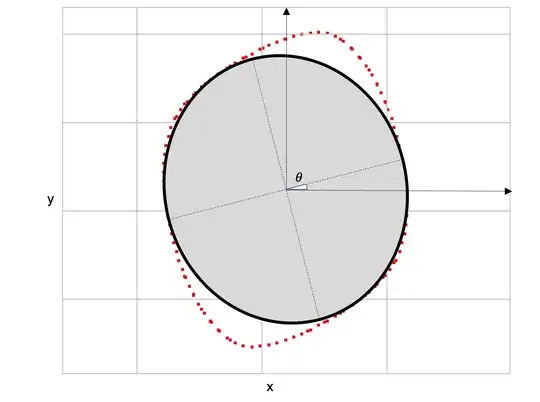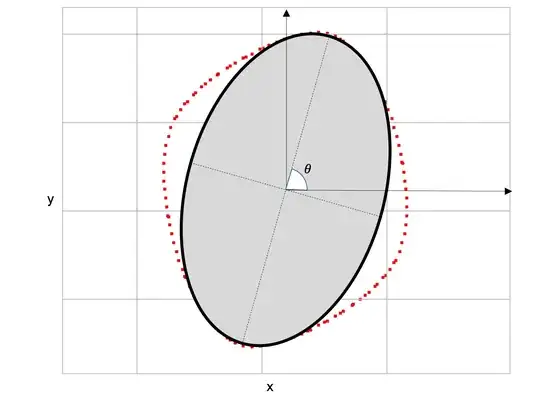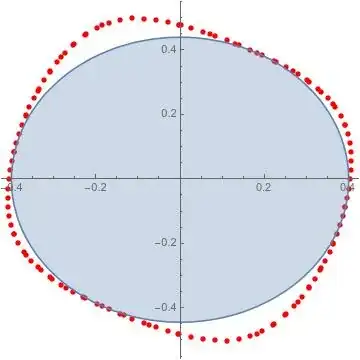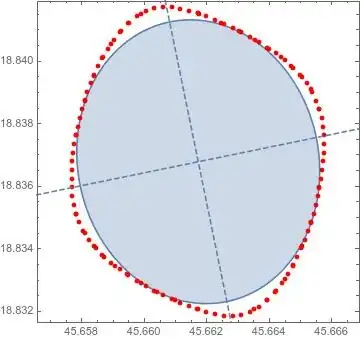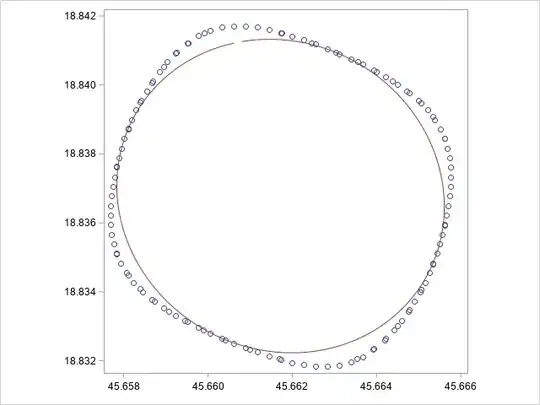I have a set of $(x, y)$ coordinates, from which I would like to generate an ellipse of maximum possible area which is entirely contained within the area defined by the given points. The points are from contour lines and not given by an equation, but generally appear in the shape of skewed ellipses.
For example, for the following points,
| x | y |
|---|---|
| 45.66172222222225 | 18.841511212833733 |
| 45.66144444444447 | 18.841603609265974 |
| 45.661166666666695 | 18.84167023720114 |
| 45.66088888888892 | 18.841708840666733 |
| 45.66061111111114 | 18.841714721198922 |
| 45.66033333333336 | 18.8416792127312 |
| 45.66005555555558 | 18.841586913726573 |
| 45.659907959603544 | 18.8415 |
| 45.659777777777805 | 18.841432324588876 |
| 45.65952133520022 | 18.84122222222222 |
| 45.65950000000003 | 18.841205864567236 |
| 45.65925240431259 | 18.840944444444442 |
| 45.65922222222225 | 18.84091291427614 |
| 45.65903462855747 | 18.840666666666664 |
| 45.65894444444447 | 18.840543213692058 |
| 45.658848018922384 | 18.84038888888889 |
| 45.658686482591534 | 18.84011111111111 |
| 45.6586666666667 | 18.840075891391127 |
| 45.65854057470615 | 18.83983333333333 |
| 45.65841385937155 | 18.839555555555553 |
| 45.658388888888915 | 18.839497076739338 |
| 45.65829635419802 | 18.839277777777777 |
| 45.65819317225286 | 18.839 |
| 45.65811111111114 | 18.838743972287034 |
| 45.658103781273304 | 18.83872222222222 |
| 45.65801729926895 | 18.83844444444444 |
| 45.657943630825045 | 18.838166666666666 |
| 45.65788130483856 | 18.837888888888887 |
| 45.65783333333336 | 18.837633786630168 |
| 45.65782843965894 | 18.83761111111111 |
| 45.657777930516 | 18.83733333333333 |
| 45.65773797205481 | 18.837055555555555 |
| 45.65770846520107 | 18.836777777777776 |
| 45.65768983794373 | 18.836499999999997 |
| 45.65768315829199 | 18.836222222222222 |
| 45.657690315425526 | 18.835944444444443 |
| 45.657714290504025 | 18.835666666666665 |
| 45.65775954170573 | 18.835388888888886 |
| 45.65783252126027 | 18.83511111111111 |
| 45.65783333333336 | 18.835108788071842 |
| 45.65792541129527 | 18.834833333333332 |
| 45.65806060225678 | 18.834555555555553 |
| 45.65811111111114 | 18.834474038899852 |
| 45.65823358922209 | 18.834277777777775 |
| 45.658388888888915 | 18.834082623685447 |
| 45.658457173026996 | 18.834 |
| 45.6586666666667 | 18.833784998750474 |
| 45.658731945343874 | 18.83372222222222 |
| 45.65894444444447 | 18.83353762228444 |
| 45.65906160654751 | 18.833444444444442 |
| 45.65922222222225 | 18.83332268424614 |
| 45.65945121712184 | 18.833166666666664 |
| 45.65950000000003 | 18.833133439986426 |
| 45.659777777777805 | 18.83295712908462 |
| 45.659898642372674 | 18.83288888888889 |
| 45.66005555555558 | 18.832794864416265 |
| 45.66033333333336 | 18.832647295512253 |
| 45.66040951888557 | 18.83261111111111 |
| 45.66061111111114 | 18.832503587959618 |
| 45.66088888888892 | 18.832375253663077 |
| 45.66099358303661 | 18.83233333333333 |
| 45.661166666666695 | 18.832250897046737 |
| 45.66144444444447 | 18.83213848859703 |
| 45.66169543834408 | 18.832055555555552 |
| 45.66172222222225 | 18.832044342721858 |
| 45.66200000000003 | 18.831951946289568 |
| 45.6622777777778 | 18.83188531835439 |
| 45.662555555555585 | 18.83184671488883 |
| 45.66283333333336 | 18.831840834356605 |
| 45.663111111111135 | 18.831876342824323 |
| 45.66338888888892 | 18.831968641828965 |
| 45.663536484840996 | 18.832055555555552 |
| 45.66366666666669 | 18.83212323096666 |
| 45.663923109244294 | 18.83233333333333 |
| 45.663944444444475 | 18.832349690988305 |
| 45.66419204013188 | 18.83261111111111 |
| 45.66422222222225 | 18.832642641279445 |
| 45.66440981588704 | 18.83288888888889 |
| 45.664500000000025 | 18.83301234186348 |
| 45.664596425522106 | 18.833166666666664 |
| 45.664757961852935 | 18.833444444444442 |
| 45.66477777777781 | 18.833479664164482 |
| 45.664903869738325 | 18.83372222222222 |
| 45.66503058507293 | 18.834 |
| 45.66505555555558 | 18.834058478816264 |
| 45.66514809024647 | 18.834277777777775 |
| 45.66525127219165 | 18.834555555555553 |
| 45.66533333333336 | 18.834811583268447 |
| 45.66534066317122 | 18.834833333333332 |
| 45.66542714517556 | 18.83511111111111 |
| 45.66550081361947 | 18.835388888888886 |
| 45.66556313960594 | 18.835666666666665 |
| 45.66561111111114 | 18.83592176892534 |
| 45.66561600478556 | 18.835944444444443 |
| 45.665666513928514 | 18.836222222222222 |
| 45.66570647238968 | 18.836499999999997 |
| 45.665735979243436 | 18.836777777777776 |
| 45.665754606500776 | 18.837055555555555 |
| 45.66576128615252 | 18.83733333333333 |
| 45.66575412901897 | 18.83761111111111 |
| 45.665730153940466 | 18.837888888888887 |
| 45.665684902738775 | 18.838166666666666 |
| 45.66561192318422 | 18.83844444444444 |
| 45.66561111111114 | 18.83844676748368 |
| 45.665519033149245 | 18.83872222222222 |
| 45.66538384218772 | 18.839 |
| 45.66533333333336 | 18.8390815166557 |
| 45.66521085522241 | 18.839277777777777 |
| 45.66505555555558 | 18.83947293187009 |
| 45.66498727141749 | 18.839555555555553 |
| 45.66477777777781 | 18.83977055680508 |
| 45.664712499100624 | 18.83983333333333 |
| 45.664500000000025 | 18.84001793327112 |
| 45.66438283789701 | 18.84011111111111 |
| 45.66422222222225 | 18.840232871309414 |
| 45.66399322732267 | 18.84038888888889 |
| 45.663944444444475 | 18.840422115569137 |
| 45.66366666666669 | 18.840598426470944 |
| 45.66354580207184 | 18.840666666666664 |
| 45.66338888888892 | 18.84076069113929 |
| 45.663111111111135 | 18.840908260043292 |
| 45.663034925558904 | 18.840944444444442 |
| 45.66283333333336 | 18.841051967595934 |
| 45.662555555555585 | 18.84118030189247 |
| 45.66245086140788 | 18.84122222222222 |
| 45.6622777777778 | 18.841304658508818 |
| 45.66200000000003 | 18.8414170669585 |
| 45.66174900610049 | 18.8415 |
| 45.66172222222225 | 18.841511212833733 |
and given the centre of the points $(h, k)$,
And the equation for an ellipse that is not at the origin and is rotated by an angle (taken from the answers at What is the general equation of the ellipse that is not in the origin and rotated by an angle?),
$$\frac{((x−h)\cos(A)+(y−k)\sin(A))^2}{a^2}+\frac{((x−h)\sin(A)-(y−k)\cos(A))^2}{b^2}=1$$
I would like to calculate the variables $a$, $b$ (the semi-axes respectively) and $A$ (the angle of rotation of the ellipse from the x-axis) for an ellipse of the largest possible area, from which I will be able to construct an ellipse of the same size and angle at any point $(h, k)$.
My initial idea was to find the minimum radius of the area defined by the points and centred on $(h, k)$, then find the radius of the same area at an angle of 90 degrees from the minimum, but a very rough calculation appears to show that this will include some amount of area outside the boundary defined by the points. For the ellipse to fit within the points, the major axis must then be narrower than the total width of the area at that angle.
On the other hand, another possibility would be to find the maximum radius of the area defined by the points and centred on $(h, k)$, then find the radius of the same area at an angle of 90 degrees from the maximum, but once again this includes some amount of area outside the point boundary, and for the ellipse to fit within the points, the minor axis must then be narrower than the total width of the area at that angle.
It is difficult to tell which method will yield an ellipse of larger possible area by these rough plots, or if there is yet another superior method; so I ask, is there a method or algorithm to determine this analytically? If it is possible to use an equation for a skewed ellipse to cover an even larger area then that would be even better - the aim is to generate an equation for a shape covering the maximum amount of area defined by the points, to then be able to determine the width of the resulting shape at any angle.

